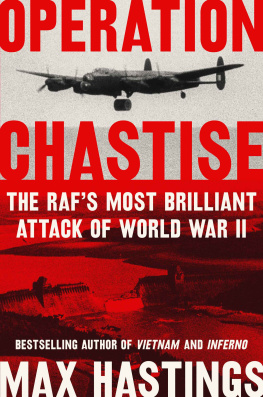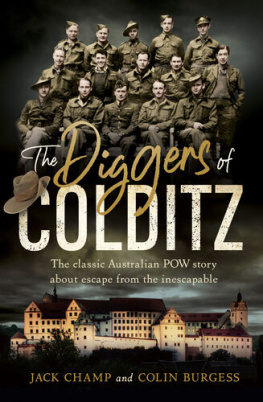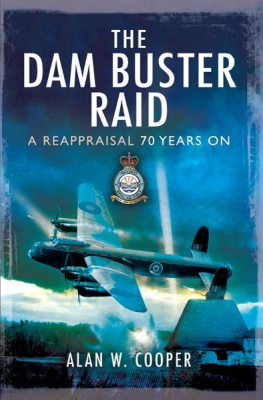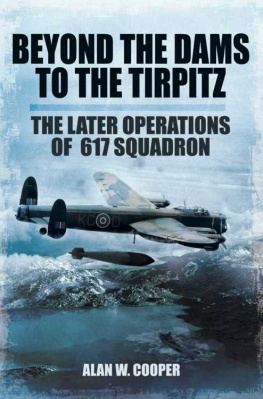Acknowledgements
M any people and organisations have been generous in sharing their knowledge and expertise with me over the years on matters relevant to this book.
Michael Gibson, Guy Gibsons nephew, responded cheerfully and helpfully to yet another person interested in his uncle. The same was true of Trish Knight-Webb, Guy Gibsons cousin. Vic Strike, a more distant relative, showed, while being most helpful, both his deep respect for Gibson and how he loved his native Cornwall, as did Gibson. Squadron leader George Johnny Johnson, DFM, was also tolerant of enquiries about Gibson, the like of which he has received many times before. Robert Owen willingly shared his vast knowledge of No 617 Squadron. Richard Morris, an outstanding writer on Gibson, was happy to enter into correspondence. From the vantage point of the museum at the Derwent Dam in Derbyshire, Vic Hallam provided his own perspective.
Chris Nathan, archivist at St Edwards School, never objected to questions, in sickness and in health.
Richard Hunting CBE, Group Captain Patrick Tootal, OBE, DL, Martin Mace and John Grehan were much valued sources of information and suggestions. Patricks interest in Bomber Command stems from the contribution made by his father. Flight Lieutenant Jack Stuart Tootal was the skipper of a Halifax lll of No 462 Squadron in No 100 Group, lost with no survivors, over the Ruhr, during the night of 24/25 February 1945.
Not for the first time, Victoria Thompson demonstrated an ability to find gems in archive dust.
Gary Godel revealed yet again his remarkable knowledge of the RAF in the Second World War.
My wife, Margaret, was an enormous help throughout the process. Another family member, Susan Wacker, happily has German as her native language and the excellent English to make her findings clear to me. Gert Falbe also contributed in this regard.
The late Richard Todd, OBE and the late Richard Leech, have over the years provided the actors view, the latter through his friendship with my brother Stephen.
There are many other people and organisations who I want to thank for information and assistance over a long period. They include:
Air Historical Branch (RAF)
Frank Armstrong
Avro Heritage Centre
Maurice Bann
Suzanne Bidlake
Phil Bonner
Gerry Burke
Alan Cooper
Sebastian Cox
Dr Jeremy Crang
Hazel Crozier
Philip Curtis
Group Captain Alex Dickson OBE, QVRM, AE
Mervyn Hallam
Dave Harrigan MBE
Flight Lieutenant Duncan Hewat
Harry Holmes
Dom Howard
Flight Lieutenant Bernard Hyde, AE
Imperial War Museums
Squadron Leader Tony Iveson DFC, AE
John Oxley Library
Stuart Millson
Howard Lee
Edward McManus
Bill Morran
No 617 Squadron
Muriel Pavlow
Tim Pierce
Douglas Radcliffe MBE
RAF Scampton Museum
Jim Shortland
Colin Smith, Vector Fine Art Prints
Flight Lieutenant Ken Trent DFC (and bar)
Appendix 1
Birth Of A Legend
T he legend begins the opening paragraphs of the front page report in The Daily Telegraph , dated 18 May 1943, followed by the result as it was seen at the time:
RAF BLOW UP THREE KEY DAMS IN GERMANY DEVASTATION SWEEPS DOWN RUHR VALLEY BRIDGES AND POWER PLANTS ENGULFED ADVANCING FLOODS STILL SPREADING FAST
With one single blow the RAF has precipitated what may prove to be the greatest industrial disaster yet inflicted on Germany in this war. A force of Lancasters, loaded with mines and with crews specially trained for the task, early yesterday morning attacked and destroyed the great dams on the Mhne and Sorpe rivers, tributaries of the Ruhr, and also the dam on the Eder River.
Today walls of water sweeping down the Ruhr and Eder valleys are carrying everything before them.
The Air Ministry announced last night that a partial reconnaissance of the Ruhr Valley and the district near the Eder dam shows that the floods are spreading fast.
The waters are sweeping down the Ruhr Valley, it stated. Railways and road bridges are broken down. Hydro-electrical power stations are destroyed or damaged, a railway marshalling yard is under water.
The floods from the breached Eder dam are already as great as the floods in the Ruhr Valley, but the country here is flatter and the water likely to spread over a greater area.
GERMANS ADMIT HEAVY CASUALTIES
The German communiqu yesterday, admitting that two dams had been damaged it did not specify the area said heavy casualties were caused among the civilian population by the resulting flood. That was as much as the people of Germany were allowed to know. There was no reference to the disaster in later news broadcasts from Berlin.
The pilots, on their return, reported seeing in the moonlight huge breaches in the dams with water bursting through. They saw a power station below the Mhne dam swept away in the flood and a 30ft high wall of water tumbling down the Eder valley.
Alongside was a photograph of Wing Commander Gibson under the heading, He drew the enemys fire.
AIR MINISTRY ACCOUNT
The full official account of the raid on the Dams in North-West Germany was given by the Air Ministry last night in the following statement:
For many weeks picked Lancaster crews had been training for one operation. They worked in secrecy on a bomber station which, as far as possible, was cut off from any contact with the outside world.
Only about half a dozen other men in the whole of Bomber Command knew what they were doing.
In the early hours of yesterday morning, when the weather and light were exactly right, they carried out the operation. The purpose was to subject the whole of the Ruhr valley to almost as severe an ordeal as it has undergone by fire in the last three months, and do the same for another industrial area farther east.
These picked men under the command of Wing Commander G.P. Gibson DSO and bar, DFC and bar, went out to attack three huge water barrage dams. Two of them were on the rivers Mhne and Sorpe, tributaries of the River Ruhr, and the other on the River Eder.
The Lancaster crews knew how much depended on their success. The opportunity might never come again, and it was an opportunity, as they knew, of doing as much damage as could be done by thousands of tons of bombs dropped on many nights running.
The Mhne and Sorpe dams control 70 per cent of the water catchment area of the Ruhr Basin. Before they were built, the Ruhr was always apt to run short of water in a dry season the Sorpe reservoir alone takes two or three years to fill.
If the reservoirs were suddenly emptied the floods that resulted could be as serious as the subsequent shortage of water: 134,000,000 tons of water would pour out from the Mhne reservoir alone.
The Result
Extracted from RAF immediate interpretation report no K.1559, dated 18 May 1943.
This was prepared by RAF Medmenham where, from April 1941, an enormous amount of photo interpretation skill was brought together.
The photographs were taken by Spitfires of No 542 Squadron on 17 May. Three sorties were flown specified as D/578, D/581 and D/585.
Locality: The Mhne, Sorpe and Eder dams
Cover and quality
On sortie D/578 the Mhne valley barrage, the greater part of the storage lake and parts of the Ruhr valley as far as twenty miles downstream are covered on prints of large scale and excellent quality. The north end of the Sorpe lake with the dam and compensating basin is also covered. The sortie does not cover the Eder dam but portions of the lake, Bringhausen storage power station, the Affoldern flow power station and the flooded parts of the country for about six miles downstream are covered.






![Bar Wing Commander Guy P. Gibson VC DSO - Enemy Coast Ahead [Illustrated Edition]](/uploads/posts/book/180257/thumbs/bar-wing-commander-guy-p-gibson-vc-dso-enemy.jpg)







